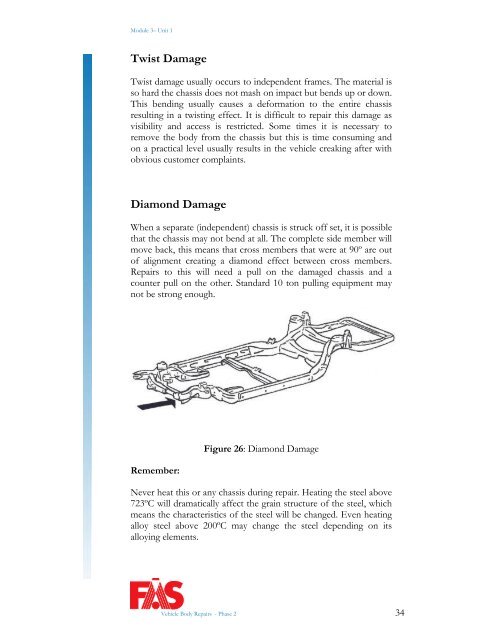TRADE OF VEHICLE BODY REPAIR - eCollege
TRADE OF VEHICLE BODY REPAIR - eCollege
TRADE OF VEHICLE BODY REPAIR - eCollege
You also want an ePaper? Increase the reach of your titles
YUMPU automatically turns print PDFs into web optimized ePapers that Google loves.
Module 3– Unit 1<br />
Twist Damage<br />
Twist damage usually occurs to independent frames. The material is<br />
so hard the chassis does not mash on impact but bends up or down.<br />
This bending usually causes a deformation to the entire chassis<br />
resulting in a twisting effect. It is difficult to repair this damage as<br />
visibility and access is restricted. Some times it is necessary to<br />
remove the body from the chassis but this is time consuming and<br />
on a practical level usually results in the vehicle creaking after with<br />
obvious customer complaints.<br />
Diamond Damage<br />
When a separate (independent) chassis is struck off set, it is possible<br />
that the chassis may not bend at all. The complete side member will<br />
move back, this means that cross members that were at 90º are out<br />
of alignment creating a diamond effect between cross members.<br />
Repairs to this will need a pull on the damaged chassis and a<br />
counter pull on the other. Standard 10 ton pulling equipment may<br />
not be strong enough.<br />
Remember:<br />
Figure 26: Diamond Damage<br />
Never heat this or any chassis during repair. Heating the steel above<br />
723ºC will dramatically affect the grain structure of the steel, which<br />
means the characteristics of the steel will be changed. Even heating<br />
alloy steel above 200ºC may change the steel depending on its<br />
alloying elements.<br />
Vehicle Body Repairs - Phase 2 34
















